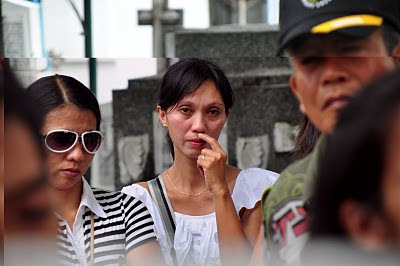I remember, however, that during the wake of my sister-in-law’s husband who died in May 2009, I volunteered to take the snapshots from the wake until the funeral. I even made from these pictures and video shots a 20-minute music video (a combination of photos and video clips). I didn’t have any idea on how my sister-in-law (my late wife’s elder sister) felt then when she looked at the pictures or watched the video after I presented them a few days after the funeral. The memories of their grief were hardwired in those episodes that I captured with my Kodak Easyshare digital camera. Would these downloadable memories help the family recover from that most sorrowful event of their lives? I don't think so.
On the third day of my wife’s wake, I brushed aside my resolve not to take any picture. That was when my kumpare and good friend, Ricky Canta, came to the wake and volunteered to take pictures during the funeral. How could I say no?
Ricky is a good friend. He was the photographer for Citylife magazine where I also worked then as assistant editor. My wife was the circulation clerk of said publication. The three of us became close friends. Ricky is tall and mild-mannered but with a good sense of humor. He was in his thirties then, married with three kids. The magazine job was just a part-time for him, as he was principally an event photographer. But in between work, he would stay in the press room until the completion of the magazine. So after a long press work, we would go out to unwind in some bar in Kalookan or Quezon City, as a treat, of course, from our tireless editor Joe Bautista.
As expected, when Rosalie and I got married in 1996 or just a few months after our meeting in the publication, Ricky was our unanimous choice for the official wedding photographer. He didn't charge for his service. He became my kumpare a year after, when he stood as a godparent for my firstborn. And of course, he also covered the baptismal ceremony. Rosalie resigned from the publication six months after the wedding. And when the magazine folded up a year later, Ricky went on his own way, establishing his photography business in Cavite. I’d lost contact with him after that. But thanks to Facebook, we were able to renew our contacts after more than a decade. He learned of Rosalie’s death only from my FB post two days after her death.
Ricky came to the wake barely an hour before midnight. He still couldn’t believe what happened to her. Before he left, he told me that he will take charge of the photography during the funeral. Free of charge. I just said “Yes, and thanks,” but with the condition that he would not take any close-up of my wife in the coffin.
Ricky had a total of 682 shots during the funeral, taken from the early morning before the necrological mass up to the parting of the guests in the cemetery. It’s a helluva lots of pictures—sad, poignant images—now stored in a DVD-R.
According to American author Eudora Welty, a good snapshot stops a moment from running away. They stay, and in these particular snapshots from Ricky, the emotion lingers. But at a second look, these shots are work of an artist. The shots are full expression of what he felt about his subject. They are drawn on an inspiration, rattled only by a grief of his own, as I caught him with tears while focusing on his angles.
Here are just a few of his shots. I might put the title “Grief” on top of the sample, because that's what is all about. I rather forget this little pang of unease that evoke those painful memories. The reality is beside the point now; the images were all that mattered.










No comments:
Post a Comment